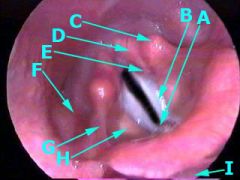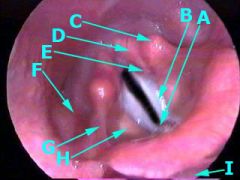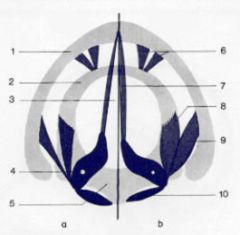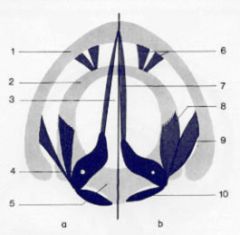![]()
![]()
![]()
Use LEFT and RIGHT arrow keys to navigate between flashcards;
Use UP and DOWN arrow keys to flip the card;
H to show hint;
A reads text to speech;
66 Cards in this Set
- Front
- Back
|
What three functions does the larynx provide?
|
1. airway support
2. airway protection 3. voice |
|
|
Vocal fold paralysis can affect ____, ____, ____, or ____.
|
voice, airway, swallowing, or all three
|
|
|
How can you distinguish between paralysis and fixation?
|
Palpation of the cricoarytenoid joint.
|
|
|
True or False
Motor loss is responsible for significant functional difficulty. |
False.
Motor or sensory loss can be responsible for significant functional difficulty. |
|
|
True or False
Isolated sensory loss cannot occur in the absence of motor deficit |
False. Sure it can.
|
|
|
____, ____, and _____ can be seen in unilateral sensory loss. Bilateral sensory loss leads to ______ and _____.
|
Throat clearing, paroxysmal coughing, vague foreign body sensations.
severe aspiration & pneumonia |
|
|
Disorders that can result in isolated sensory loss include ____ and ____.
|
Guillan-Barré and diabetes
|
|
|
Above the vocal folds the sensory innervation of the larynx is via the ____. Below the vocal folds it is by way of branches of the ____.
|
Above the vocal folds the sensory innervation of the larynx is via the INTERNAL (SUPERIOR) LARYNGEAL NERVE. Below the vocal folds it is by way of branches of the RECURRENT LARYNGEAL NERVE.
|
|
|
Which nerve innervates the cricothyroid?
|
The external branch of the superior laryngeal nerve.
|
|
|
True or False
Superior Laryngeal nerve paralysis is generally an isolated phenomenon unrelated to other neurological or laryngeal diseases. |
True
|
|
|
Can superior laryngeal nerve paralysis be caused by viral neuropathy?
|
Sure
|
|
|
_____ and ____ are common symptoms of superior laryngeal nerve paralysis, because of the rotation of the posterior commisure (part of the glottis between the arytenoids) toward ________.
|
Diplophonia & easy fatiguability
the side of paralysis |
|
|
Approximately ____ of patients experiencing superior laryngeal nerve paralysis recover spontaneously and without intervention within ____ of onset.
|
60%
1 year |
|
|
If a person does not recover from superior laryngeal nerve paralysis, what procedure might work? Is this necessary?
|
nerve-muscle pedicle reinnervation.
Rarely, since the voice change is really minimal for speaking. |
|
|
The voice quality is breathy and diplophonic and the patient cannot perform a good glottal stop. What could be wrong?
|
Unilateral paralysis of the recurrent laryngeal nerve.
|
|
|
Anterior Commissure
|

What's A?
|
|
|
True Vocal Fold
|

What's B?
|
|
|
Corniculate Cartilage
|

What's C
|
|
|
Arytenoid Cartilage
|

What's D
|
|
|
Vocal Process
|

What's E?
|
|
|
Pyriform Sinus?
|

What's F?
|
|
|
Aryepiglottic Fold
|

What's G?
|
|
|
False Vocal Folds
|

What's H?
|
|
|
Valleculae
|

What's I?
|
|
|
Epiglottis
|

What's above I?
|
|
|
open glottis
|

What's a?
|
|
|
Closed glottis.
|

What's b?
|
|
|
Thyroid cartilage
|

What's 1?
|
|
|
Ring of the cricoid cartilage
|

What's 2?
|
|
|
rima of the glottis
|

What's 3?
|
|
|
Axis of rotation for the arytenoid cartilage.
|

What's 4?
|
|
|
Cricoid cartilage plate
|

What's 5?
|
|
|
Cricothyroid muscle.
Tilting movements and rough vocal chord tension |

What's 6 and what does it do?
|
|
|
Vocalis muscle
Fine adjustment of vocal chord tension |

What's 7 and what does it do?
|
|
|
Lateral cricoarytenoid muscle.
TVF adductor |

What's 8 and what does it do?
|
|
|
Thyroarytenoid muscle
Adducts the TVF |

What's 9 and what does it do?
|
|
|
Posterior cricoarytenoid.
Abducts the TVF. |

What's 10 and what does it do?
|
|
|
a
TVF abducted. |

a or b? What's the result?
Contraction of the opening muscles and relaxation of the closing muscles |
|
|
b
TVF adducted. |

a or b? What's the result.
Contraction of the closing muscles and relaxation of the opening muscles. |
|
|
b
|

a or b?
Which position corresponds to the partial paralysis of the recurrent laryngeal nerve? |
|
|
In unilateral paralysis of the recurrent laryngeal nerve, the paralyzed VF rests in the ______ position rather than the _____ position because of the unopposed _____ pull of the intact ______ muscle innervated by ______ branch of the vagus.
|
In unilateral VF paralysis, the paralyzed VF rests in the paramedian position rather than the neutral or intermediate position because of the unopposed medializing pull of the intact cricothyroid muscle innervated by external superior laryngeal branch of the vagus.
|
|
|
True or False
With unilateral paralysis of the recurrent laryngeal nerve, the mobile vocal fold often eventually compensates for the paralyzed vocal fold. |
True
|
|
|
True or False
With unilateral paralysis of the recurrent laryngeal nerve, the patient may complain of shortness of breath because of rapid air escape, necessitating frequent breaths. |
False
only on speaking |
|
|
True or False
With unilateral paralysis of the recurrent laryngeal nerve, there may still appear to be slight adduction on phonatory effort. However, the vocal fold does not adduct from its position of rest. |
False.
abduct from its position of rest. |
|
|
What are three symptoms of an isolated sensory loss?
|
Throat clearing, paroxysmal coughing, and vague foreign body sensations.
|
|
|
True or False.
Recurrent laryngeal nerve paralysis is frequently idiopathic. |
True
|
|
|
True or False.
Bilateral recurrent laryngeal nerve paralysis occurs most often as the result of stroke or other TBI. |
False.
most frequently occurs as the result of surgical or other trauma |
|
|
Why can serious airway compromise occur from bilateral recurrent laryngeal nerve paralysis?
|
The patient has lost the ability to abduct the vocal folds.
|
|
|
In bilateral recurrent laryngeal nerve paralysis, because the ______ nerve activity adducts the paralyzed vocal folds close to midline, _____ is usually close to normal, but _____ is generally affected.
|
Superior laryngeal nerve activity adducts the paralyzed vocal folds close to midline, voicing is usually close to normal, but pitch control is generally affected.
|
|
|
True or False
Combined paralyses of recurrent and superior laryngeal nerves are more common than isolated nerve palsies. |
False.
They are less common. |
|
|
What would cause bilateral paralyses of the recurrent and superior laryngeal nerves?
|
Damage to CNS or base of skull where the nerve branches are in close proximity.
|
|
|
True or False
Immobile vocal folds are slightly more abducted in isolated bilateral recurrent nerve paralysis than in combined bilateral paralysis. |
False.
More abducted with combined bilateral paralysis. |
|
|
Are findings in combined unilateral paralysis more like those found in unilateral recurrent or unilateral superior laryngeal nerve paralysis?
|
unilateral recurrent
|
|
|
True or false
Competency of the glottis is worse with combined unilateral paralysis. |
True
Loss of sensation in the supraglottic area results in paroxysmal coughing and aspiration |
|
|
True or False
In many cases, vocal fold paralysis or dysfunction recovers spontaneously within 6 months of onset, providing the nerve is not destroyed. |
False
1 year. |
|
|
Why is an accurate diagnosis of vocal fold paralysis or dysfunction critical?
|
So that the interventions chosen will not prevent spontaneous recovery or compensation.
|
|
|
Irreversible intervention should not be considered until 1 year after onset of TVF dysfunction, except:
|
to stabilize the airway and/or deal with intractable aspiration
|
|
|
___ of patients with a unilateral recurrent laryngeal nerve paralysis should receive voice therapy.
|
100%
|
|
|
Surgical intervention is necessary in ____ of cases of unilateral recurrent laryngeal nerve paralysis. Procedures include _____, _____ and _____,
|
10-15%
Teflon (gelfoam) injection Surgial medialization Reinnervation |
|
|
______ is the only technique currently available that restores ability to change tension in the vocal fold for pitch control as well as active medialization.
|
Reinnervation
|
|
|
True or False
Bilateral recurrent laryngeal nerve paralysis usually requires intervention to stabilize the airway. |
True
|
|
|
What three interventions are often used with bilateral recurrent laryngeal nerve paralysis?
|
Tracheotomy
Surgical lateralization Nerve-Muscle Pedicle Reinnervation |
|
|
Surgical lateralization techniques that remove the arytenoid cartilage and/or lateralize the paralyzed vocal fold will regain airway at the expense of what?
|
Residual voice
|
|
|
Nerve muscle pedicles can be transposed from the ____ to the ___ to acheive abduction within _____.
|
omohyoid
cricoarytenoid 2-6 months |
|
|
Nerve-muscle pedicle reinnervations are successful in restoring adequate airway in _____ of cases.
|
80%
|
|
|
What three things should be considered regarding bilateral VF paralysis?
|
1. adequate airway
2. eating and drinking without aspiration 3. managing own secretions |

